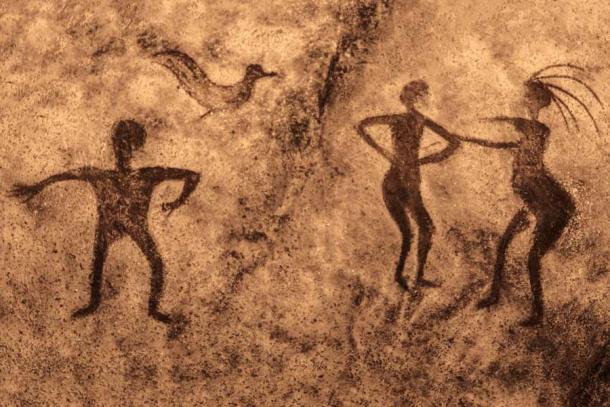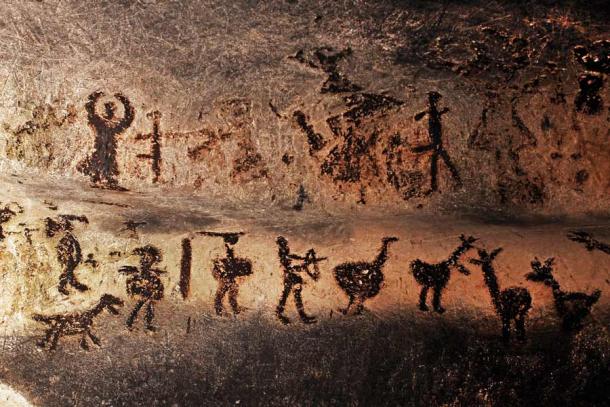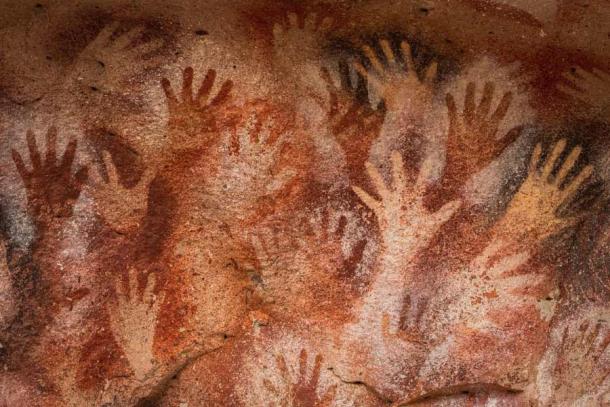Getting stoned, or high, has always been a way to escape the pressures of day-to-day reality. However, modern artists and psychonauts are at the end of a long chain of stoners that apparently began with subterranean artists working in caves who were starved of oxygen and thus “high.” A team of Tel Aviv University archaeologists have published a new paper published in Time and Mind: The Journal of Archaeology, Consciousness and Culture showing that subterranean artists working in deep caves, 50,000 to 12,000 years ago, were likely intoxicated while doing so. What is special about these particular Upper-Paleolithic art works is that the chances are high that the artists were also high.

Subterranean artists painted cave scenes like this one in deep caves where a lack of sufficient oxygen resulted in hypoxia, which likely caused a heightened state of euphoria. ( gerasimov174 / Adobe Stock)
Tripping? Ancient Subterranean Artists In Low-oxygen Caves
While many recreational drug users today associate their experiences with uncharted dimensions and planes of existence, a 2011 report discussed in the New Scientist explained how psychedelic drugs “cut brain blood flow and connections in regions known as the thalamus.”
The team of Israeli archaeologists have suggested that the subterranean artists they studied, all over Europe “were tripping” when they created rock art because the reduced oxygen in deep caves would have caused “ hypoxia” (oxygen deprivation) in their brains leading to a state of euphoria.
When blood flow to the brain is impaired the results can be catastrophic. This is similar to what happens when someone has a stroke. However, when blood flow is altered by certain drugs, users can experience altered states of consciousness. With larger quantities of psychotropic chemicals , blood flow is further tampered with and the user can experience “euphoria, out-of-body experiences and perhaps even hallucinations,” according to the new study.

Were these prehistoric mural drawings in the Magura cave, Bulgaria made by subterranean artists that were “high” due to a lack of sufficient oxygen? ( MEDIAIMAG / Adobe Stock)
Which Was More Important, The Cave Or the Trip?
The Israeli research team speculated that the ancient subterranean artists who executed the drawings “might have believed that there was something special about the caves themselves.” Without having a scientific understanding of blood flow to the brain the ancient artists most probably interpreted their experiences “as metaphysical in nature.” The authors said it was maybe “not the decoration that rendered the caves significant, rather, the significance of the chosen caves was the reason for their decoration.”
In another paper the same authors said the rock face within the cave was conceived “as a membrane, a tissue connecting the here-and-now world and the underground world beyond.” The archaeologists think that when someone made the conscious choice to enter these deep, dark environments, it was “motivated by an understanding of the transformative nature of an underground, oxygen-depleted space.”

Ancient cave paintings of hands at Cueva de Las Manos in Santa Cruz Province, Patagonia, Argentina. ( R.M. Nunes / Adobe Stock)
Tripping In Ancient Times Has Been Well Documented
An article about ancient “drugs” and the euphoria produced by low-oxygen environments wouldn’t be complete without mentioning that Moses was “apparently high” when god spoke to him on the top of Mount Sinai. And in the same article in The Guardian in which this idea is discussed, Dr Benny Shanon, a professor of cognitive psychology at the Hebrew University of Jerusalem, asked if the “Ten Commandments are a result of divine inspiration alone?” Furthermore, he suggested psychedelic drugs “formed an integral part of the religious rites of Israelites in biblical times.”
Writing in the Time and Mind journal of philosophy in October 2020, Shanon describes a drug made with the bark of the acacia tree that was “frequently mentioned in the Old Testament.” The researcher found a sample to contain the same molecules as those found in plants from which the powerful Amazonian hallucinogenic brew ayahuasca is prepared. He suggested, “The thunder, lightning and blaring of a trumpet which the Book of Exodus says emanated from Mount Sinai could just have been the imaginings of a people in an altered state of awareness.”
Shanon said references in the Bible where people “see sounds” is a classic phenomenon similar to the reports from advanced forms of ayahuasca inebriation where users in religious ceremonies report seeing music and light accompanied by profound religious and spiritual feelings.
As far as Moses on Mount Sinai is concerned, Shanon doesn’t believe it was a supernatural or cosmic event, but he suspects it was “very probable, an event that joined Moses and the people of Israel under the effect of narcotics.”
Shanon, who publicly admitted to dabbling with psychotropic substances, also thinks Moses was probably also on mind-altering drugs when he saw the “burning bush.”
Top image: Is this subterranean artist in a state of euphoria because he took “drugs” or simply because the cave he was painting in had too little oxygen? Source: Gorodenkoff/ Adobe Stock
By Ashley Cowie
Related posts:
Views: 0
 RSS Feed
RSS Feed
















 April 10th, 2021
April 10th, 2021  Awake Goy
Awake Goy  Posted in
Posted in  Tags:
Tags: 
















